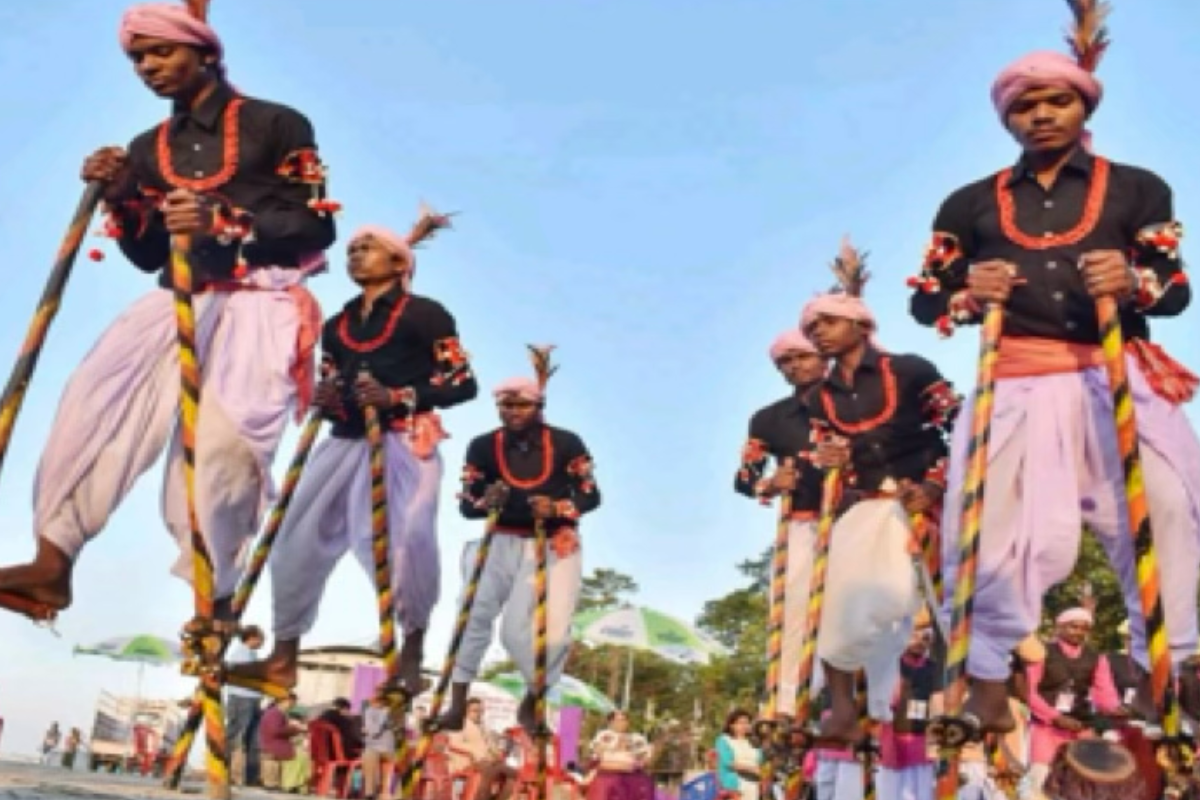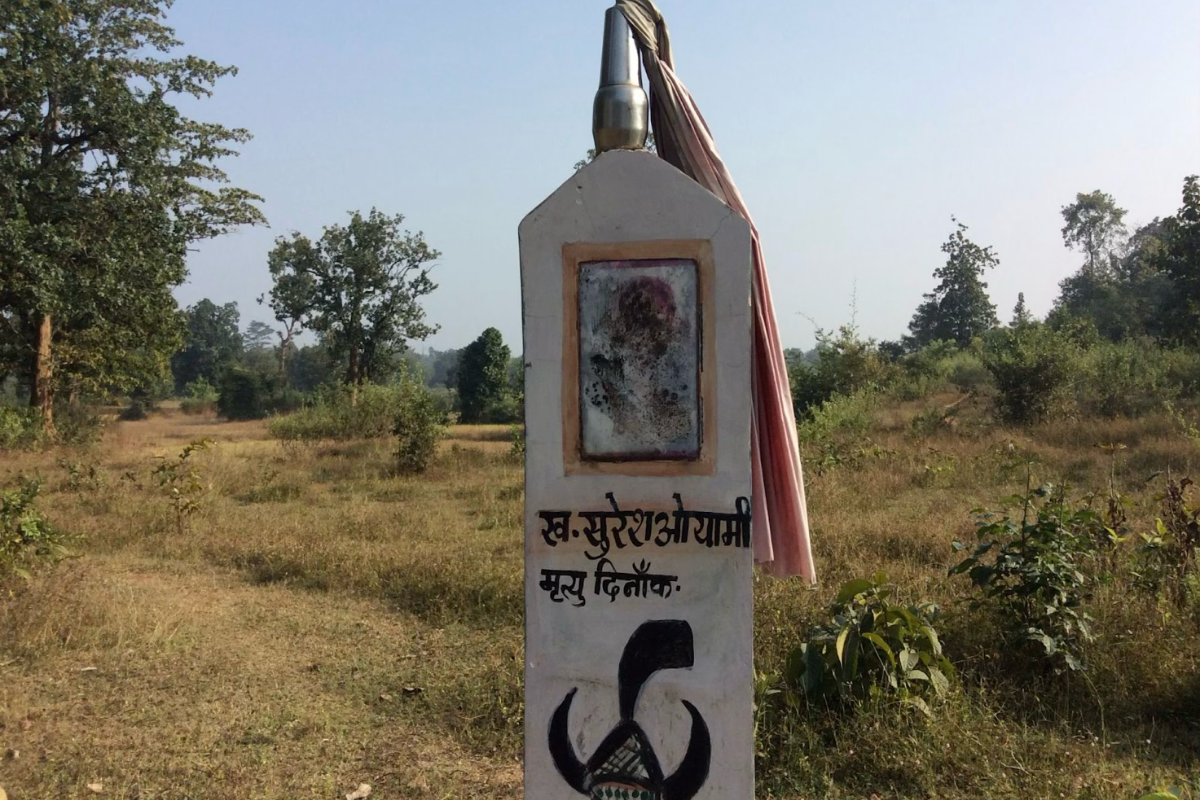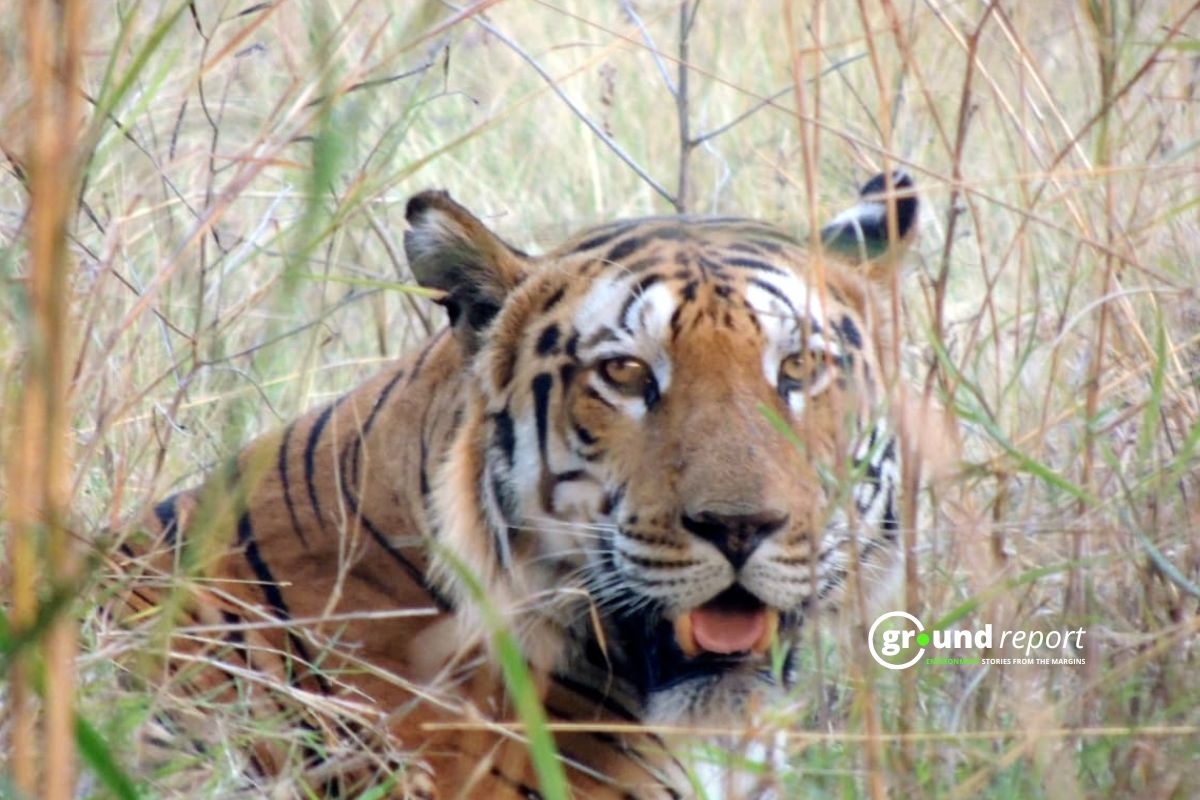Bishnoi tribes are considered conservationists as the preservation of animal and vegetable life is a religion to them. Bishnoi tribes are immigrants from the northern part of India. It was formerly a Hindu sect founded in the state of Punjab. Later, it has developed into a caste. Bishnoi tribe inhabits the area around Barmer and traces their ancestry to a saint and ascetic named Jambhaji, regarded by them as an incarnation of Lord Vishnu, whom they worship. Bishnoi tribe has a sizeable population in the adjoining areas of Uttar Pradesh, Haryana, Punjab, Uttarakhand, Madhya Pradesh, Delhi, Maharashtra and Gujarat. The Bishnois are presently prevalent in the western parts of Rajasthan.
Bishnoi sect was formed by Guru Jambheshwar after a drought in Marwar region. He created a community with 29 principles to be followed. He directed the worship of Lord Vishnu, while banning animal killing and cutting of trees. An interesting rationale for the name of Bishnoi is that the sect follows twenty-nine doctrines and Bishnoi in the local dialect translates to twenty-nine. The Bishnois are strict vegetarians and also ardent protectors of trees and wildlife. Ten doctrines among the twenty-nine are directed towards personal hygiene and maintaining good basic health, seven for healthy social behaviour, and five tenets to worship God. Eight tenets have been prescribed to preserve bio-diversity and encourage good animal husbandry.
The Bishnoi rules teach followers to be merciful towards all living beings and to love and feel pity for them. They provide shelter for animals and do not slaughter them. Moreover, they do not sterilize bulls. Their concern for living beings includes not only animals but also plants and trees. They forbid the cutting of green trees. They are completely vegetarians and do not use substances like opium, hemp, tobacco, liquor and the like. The menfolk dress primarily in whites to curb the use of dyes that are harmful to the environment. They do not even use blue colour extracted from indigo. The core aim is to save the environment in every way possible and not to exploit the naturally available resources.
The doctrine of concern towards non-humans is well embedded in the Bishnois’ psychological makeup and they try to carry out all of their life activities in an eco-friendly manner. They use filtered water and milk only. If they find any animal or insect during the process of filtering, they make it a point not to harm it and put it back into its habitat. Bishnois, use firewood from dead trees and cow dung as fuel for other purposes. They are also careful when using firewood or cow dung to harm any insect or small living being that may be hidden in it. They try to consume the least amount of natural resources as possible. Thus, they prefer to recycle available natural resources as far as possible.
Bishnois do not cremate dead bodies. Rather than cremating, they bury the bodies in their own, usually on their agricultural land. In doing so, they surely can reduce the carbon footprint significantly because cremation not only requires a lot of firewood from trees, but the process also releases carbon dioxide and other harmful gases at large levels leading to an increased carbon footprint.
The communities have a particular non-human area in their villages, separated from their place of living which is considered sacred because they believe that this particular land has spiritual influence. It is considered as the heavenly abode for gods and ancestral spirits and hence, all the available biodiversity is preserved here. In general, cutting of trees, killing of animals and collecting materials are forbidden in these areas. These areas, apart from being home for many endangered animals and birds, also have many rare varieties of crops, herbs and other important medicinal plants that are important for a balanced ecosystem. These groves, at times, also have secret reservoirs of water, which are extremely important in desert areas of Rajasthan
The villages where the Bishnoi tribes reside are easily distinguishable because of the abundance of trees and other vegetation. The herds of antelopes roaming freely near their homes. The people do their agricultural works with simple ploughs using bullocks or camels keeping in mind the ecosystem of the desert land. They rear sheep and goats, which devour desert vegetation. They have strong love for animals which prevent them from slaughtering them or selling any of animal products. Animals are sacred and the protection of animals is part of the Bishnoi culture. The Bishnoi tribe has developed a unique blend of ecological sense and religious sensibility and strictly follows some customs that bar them from cutting trees and are also advocates of peace and non-violence. During marriage ceremonies, the bridegroom is welcomed by the bride’s mother. After that both bride and bridegroom are made to seat on wooden boards. The wedding is performed in presence of a caste priest. Widow re-marriage is allowed in a Bishnoi society. In their community, dead are never burnt. They throw the bodies into a stream. They follow several birth and funeral rites
The people of this community are teetotalers and wear white shirt, dhoti and turban which also enable them to stave off from the hot dry desert climate. Only one crop of bajra is grown during the monsoon season by the tribal people. The costumes of the Bishnoi tribe display their tribal customs including their sense of mores. The puthia, pada or pothdi and odhna make up the entire ensemble of unmarried girls. The ‘puthia’ is white with full sleeves and the piping on the ‘puthia’is red. The lower garment of the women is called a ‘pada’. It is made from a blend of cotton and wool or in pure wool. The fabric is woven in black and white checks and the skirt is generally referred to as a ‘dhabla’. Bishnoi ‘odhnis’ display a variety of prints, like the ‘rati-chunri’, a red printed ‘chunri’, the ‘sundripakodi’ in cotton and the ‘ludi’, which is black. The ‘ludi’ is a woollen shawl made from sheep wool and is often embroidered. A married woman wears a kanchli with a kurti, a dhabla or ghaghra as her lower garment and an odhna. The neckline is generally decorated with a small frill and small bells are attached just below the tuki, drawing attention to the garment. Sleeves are worn longer than in other communities and are tight at the edge. Often two to three pleats are made at the border of the sleeve and are trimmed with piping.
The dresses are made with great dexterity for marriage purpose. For the marriage ceremony a kanchli made of mashru is preferred. The wedding lehenga is pink or red. A red chhint fabric in cotton, with white circles and black borders called jalebchaap is most commonly used for this lehenga. The border designs at the two ends are brought to the front to form a vertical design down the centre of the ghagra. Sometimes, the ghagra is given a permanent pleat-effect with the use of natural glue, called morla. The Bishnoi women wear different varieties of odhni. Generally, during the marriage ceremony, the ‘pirkichunri’, gifted by the bride’s mother, is worn. This is a draped garment, printed in ‘laungbhat’. A ‘kajliodhni’ or ‘cha-pal chunri’ is also used for the marriage ceremony. Another odhni is the kangrechiodhni, which has bandhej work on fine mulmul. The damini, an embroidered red odhna is also popular. The edging of an odhna is finished with double piping, generally blue and yellow. Women use the ludi and lunkar as shawls. A widow’s dress is similar in styling but lacks ornamentation and the colours used among them are either plain black for older women and red and black for younger widows.
The Bishnoi man’s attire comprises the chola, the dhoti and the pagadi. The chola is worn as an upper garment and is usually made of white cotton. A dhoti is worn as the lower garment and is made of white cotton fabric and is worn at ankle-length. The men of this tribal community prefer to wear headgears. The headgear of the Bishnoi men is known as the potiya. It is white and worn at all times. The fabric used is cotton and the men are fond of jewellery and wear murki in their ears.
Bishnois, even in the extreme climatic conditions of Rajasthan, have managed to protect the flora and fauna of the Thardesert, and have also helped them to thrive in all these years. They strongly believe in rainwater harvesting, even at the smallest levels like keeping pitchers outdoors in rain to store rainwater for household uses. Moreover, the stress upon keeping the river banks and other water bodies like ponds, lakes, clean so that they don’t get contaminated and spread contagious diseases.
Bishnois use traditional detergents like Reetha (Sapindusmukorossi) for washing clothes. They utilize ashes and sand for cleaning utensils, with minimal water. They use diluted buttermilk for bathing themselves. Since this water is free from any chemicals, it is diverted to tree pits and other irrigation purposes. Hence, recycling of water is an important aspect of Bishnoi practices
The famous Amrita Devi Chipkoo movement is considered to be among the pioneering efforts for environmental protection. In this movement, 363 Bishnois laid down their lives for the protection of Khejri trees in Khejarli village of Rajasthan. According to the well-known story/legend, King Abhay Singh of Jodhpur, in the 1730s, when building his new palace, ordered his soldiers to cut down the trees for wood in Khejarli village. As a symbol of protest, a lady named Amrita Devi stood against the soldiers and fought for the life of trees by clinging onto them. Her three daughters, Asu, Ratni, and Bhagu also stood by their mother.
The last words of Amrita Devi were, “Sarsanteyrookhrahe to bhisastojaan” (a chopped head is cheaper than a chopped tree), which became the tagline of Bishnois to inspire them for all times to come. Supporting them, the other people of this community also stood up for the trees and wrapped their arms around the trunks. The soldiers continued to axe the trees down, without paying heed to the requests of the people. A messenger was sent to report regarding the same, but before the Maharaja’s orders for stopping the act could reach them, they had massacred the ones who stood in their way. Later, the Maharaja granted a royal decree on copper plaque to Bishnois proclaiming the cutting of green trees and hunting of animals within the revenue boundaries of Bishnoi village, as illegal. Furthermore, any person who violated these would be prosecuted by the state and would have to pay a heavy penalty. The decree also prohibited members of the royal family from hunting in or near Bishnoi villages.
This movement has left an indelible mark on the memories and a long-lasting effect on the psyche of the people. In order to keep the incident alive in the memories, it is commemorated every year by the locals of this area. They have constructed a huge shrine at the place where Amrita Devi was killed along with a temple nearby, to reminiscence the sacrifice of their ancestors and inspire their upcoming generations to be selfless and kind towards all living beings.
Many such sacrifices have been reported in the areas like Bhuchojiachra, and Rotu of Nagaur, Rohicha, Lohawat, Chiraav, Banaar, Kankani, Guda Bishnoi and Bhagatasani of Jodhpur, Barasan of Barmer, Karma Gora of Ramashi, Khiwani Main, Mehrana of Punjab, and the like. An annual Mela (congregation) is organized, at Khejarli village on the 10th day of Bhadra month (August or September), as per Hindi calendar where all such incidents are retold. Not only Bishnois but tourists from other parts of the world also gather to gain knowledge and offer their obeisance.
These are only some of the practices they carry out in their day-to-day lives. Even at present, in spite of technological advancement and development, they are proud to follow their centuries-old culture and lifestyle. Today, Bishnois are world-famous for the level of protection they provide to Blackbucks, which is an endangered antelope species. They still revere trees, especially the Khejri (Prosopis cineraria) tree, and never cut it under any circumstances. They also donate 10% of their earnings for wildlife welfare and protection. There is a temple named SalasarBalaji, in the Sikar district of Rajasthan.
The specialty of this temple is that its architecture and construction was carried out in such a way that no tree had to be cut. Moreover, this temple, because of its greenery, is home for many kinds of birds, especially sparrows. Another example is the shelter in Jajiwal temple, which is the habitat for peacocks and gazelles. The people in this temple and nearby areas, provide food, water, and required aids for sick and injured animals and birds.
There is a famous incident of Nadhodi district of Hisar, Haryana, where a lady named Ramidevi, breastfed an extremely weak baby deer to save its life. There are many such examples reported in villages like Lohawat (Rajasthan) and Rajala (Haryana), and other states where Bishnoismigrated. There are animal shelters and bird sanctuaries which are solely managed and protected by the Bishnoi tribes community. One such example is in the Khejarli village animal care center and migratory bird shelter.
The animal care center although government-owned is managed by the residing Bishnois in the area. They provide medicines. food and care to the wounded and weak animals. One can find many varieties of antelopes, cows, and other mammals in this area, especially the endangered blackbuck. This area is a favoured abode of migratory birds during winters, such as Siberian Cranes that are called Kurja in the local dialect, Khichan. Thus, it gets to welcome many varieties of migratory birds and is the habitat for local species too years and named as “Environmentalists since 15th Century” by the famous photojournalist Franck Vogel, we need more efforts at personal and government level to preserve the rich heritage of this special community. As per the definition of Intangible Cultural Heritage (ICH) given by UNESCO in its Convention for the Safeguarding of the Intangible Cultural Heritage, 2018 Edition, “The
“intangible cultural heritage” means the practices, representations, expressions, knowledge, skills – as well as the instruments, objects, artefacts and cultural spaces associated therewith – that communities, groups and, in some cases, individuals recognize as part of their cultural heritage. This intangible cultural heritage, transmitted from generation to generation, is constantly recreated by communities and groups in response to their environment, their interaction with nature and their history, and provides them with a sense of identity and continuity, thus promoting respect for cultural diversity and human creativity.
Bishnois are quite helpful for environmental conservation and protection. Although they have been gaining recognition at global platforms in recent years and named “Environmentalists since the 15th Century” by the famous photojournalist Franck Vogel, we need more efforts at personal and government level to preserve the rich heritage of this special community. As per the definition of Intangible Cultural Heritage (ICH) given by UNESCO in its Convention for the Safeguarding of the Intangible Cultural Heritage, 2018 Edition, “The “intangible cultural heritage” means the practices, representations, expressions, knowledge, skills – as well as the instruments, objects, artifacts and cultural spaces associated therewith – that communities, groups and, in some cases, individuals recognize as part of their cultural heritage. This intangible cultural heritage, transmitted from generation to generation, is constantly recreated by communities and groups in response to their environment, their interaction with nature and their history, and provides them with a sense of identity and continuity, thus promoting respect for cultural diversity and human creativity.
Incorporating these practices into our day-to-day lives as part of our socio-cultural heritage will complement the efforts made by the recognized and powerful committees. Even our smallest attempts, as easy as the ones followed by the Bishnois, can have a huge impact cumulatively. Their work towards the protection of the environment is very important as they focus on an individual’s contribution at grassroots levels, aggregating to form a sizable impact. Bishnois have been organic in their lifestyle, even before the concept of natural art of living was promulgated by the common mass in recent years. Their spectacular success has been made possible due to the inherent simplicity of their religious doctrines which have formed their lifestyles and cultural heritage. They have preserved memories of their sacrifices over the ages by celebrations and congregations leading to the initiation and inclusion of the youngsters into the fold by instilling a sense of pride in their legacy and not allowing public memory to fade away.
The Bishnoi tribes worship animals as God and maintain a healthy ecological balance of nature. Undoubtedly Bishnoi tribes are heroes of the conservation world, warriors of Mother Nature, who have been saving the environment for 500 years. Their contribution to environmental protection is truly worthy of global praise.

Ramya
Assistant Professor & Tribal Researcher
Department of English
P.K.R. Arts College For Women
Erode Dt Tamil Nadu
ramyaindia1947@gmail.com
ALSO READ
- What Is COP27, And Why Is It So Important?
- 5 Biggest Environmental Issues In India In 2022
- More Than 1,700 Environmental Activists Murdered In Past Decade
You can connect with Ground Report on Facebook, Twitter, Koo App, Instagram, and Whatsapp and Subscribe to our YouTube channel. For suggestions and writeups mail us at GReport2018@gmail.com









